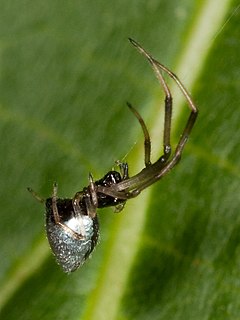
Barychelidae, also known as brushed trapdoor spiders, is a spider family with about 300 species in 42 genera. Most spiders in this family build trapdoor burrows. For example, the 20 millimetres (0.79 in) long Sipalolasma builds its burrow in rotted wood, with a hinged trapdoor at each end. The 10 millimetres (0.39 in) long Idioctis builds its burrow approximately 5 centimetres (2.0 in) deep, just below the high tide level, sealing the opening with a thin trapdoor.

Argyrodes, also called dewdrop spiders, is a genus of comb-footed spiders that was first described by Eugène Louis Simon in 1864. They occur worldwide, and are best known for their kleptoparasitism. They can spin their own webs, but tend to invade and reside in their hosts' webs. This relationship can be commensal or even mutual if the dewdrop spider feeds on small trapped insects that are not eaten by the host. Some species can even prey upon the host.

Lycosa is a genus of wolf spiders distributed throughout most of the world. Sometimes called the "true tarantula", though not closely related to the spiders most commonly called tarantulas today, Lycosa spp. can be distinguished from common wolf spiders by their relatively large size. This genus includes the European Lycosa tarantula, which was once associated with tarantism, a dubious affliction whose symptoms included shaking, cold sweats, and a high fever, asserted to be curable only by the traditional tarantella dance. No scientific substantiation of that myth is known; the venom of Lycosa spiders is generally not harmful.

Poecilotheria is a genus of Asian tarantulas that was first described by Eugène Louis Simon in 1885. They are arboreal tarantulas, commonly known as ornamental tarantulas, known for their vivid color patterns, fast movement, and potent venom compared to other tarantulas. As of 2019 all species are protected under CITES.

Idiops is a genus of armored trapdoor spiders that was first described by Josef Anton Maximilian Perty in 1833.
Heligmomerus is a genus of armored trapdoor spiders that was first described by Eugène Louis Simon in 1892.
Scalidognathus is a genus of Asian armored trapdoor spiders that was first described by Ferdinand Anton Franz Karsch in 1892. Originally placed with the Ctenizidae, it was moved to the Idiopidae in 1985.

Olios is the largest genus of huntsman spiders, containing 250 species. They are found throughout the world, with most species occurring in hot countries. The genus was first described by Charles Athanase Walckenaer in 1837.

Cyrtarachne is a genus of orb-weaver spiders first described by Tamerlan Thorell in 1868.

Neoheterophrictus is a genus of tarantula in the family Theraphosidae. It comprises seven species, all found in India.
Neoheterophrictus madraspatanus is a species of spider in the family Theraphosidae, found in India.

Chilobrachys is a genus of Asian tarantulas that was first described by Ferdinand Anton Franz Karsch in 1892.
Cyrtarachne raniceps is a species of spider of the genus Cyrtarachne. It is found in India and Sri Lanka. It is 9 mm long and has brown carapace with a heart shaped sternum.
Sipalolasma is a genus of brushed trapdoor spiders first described by Eugène Simon in 1892. It is restricted to South Asia and parts of Africa.
Oedignatha is a genus of Asian spiders first described by Tamerlan Thorell in 1881 as a genus of corrinid sac spiders, and moved to Liocranidae in 2014.

Hippasa is a genus of wolf spiders in the family Lycosidae, containing thirty five accepted species.
Haploclastus is a genus of Indian tarantulas that was first described by Eugène Louis Simon in 1892. It is considered a senior synonym of Phlogiodes.
Heterophrictus is a genus of Indian tarantulas that was first described by Reginald Innes Pocock in 1900.









